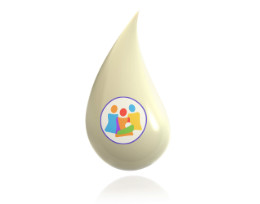Breastfeeding & Lactation After Breast or Chest Surgery or Injury
If you have had any kind of breast or chest surgery or injury (such as a burn or trauma), it may impact your ability to produce as much milk as your baby needs. There are several things you can do to encourage your body to produce milk and make sure that your baby receives enough nourishment.
Please inform your baby’s doctor and your lactation specialist if you have ever had previous surgeries, procedures, or injuries to the breast or chest of any kind.
- Breast or chest surgery or injury can impact the development of milk-making tissue. Most surgical procedures and injuries will not impact milk production significantly. Breast reduction surgery and gender-affirming chest/top surgery are the most concerning in terms of their negative impact on milk production.
- Nearly all individuals who have a breast reduction are expected to have low milk production. The least harmful techniques appear to be those in which the areola and nipple remain attached to the milk-making tissue while leaving the tissue directly beneath the nipple-areolar region in place. However, no matter the technique, breastfeeding infants need to be followed very closely to monitor their weight to ensure adequate intake. All individuals who are breastfeeding after breast reduction should be cared for by breastfeeding-knowledgeable health professionals or lactation specialists.
- Individuals who have undergone gender-affirming top surgery often have some remaining glandular tissue that will produce milk after birth. Those who decide to directly feed the baby after top surgery often refer to this as chestfeeding. Milk production is expected to be quite low after top surgery.
- Breast implants (augmentation surgery) typically do not impact milk production. However, some people decide to have breast implants because their natural breasts are unusual looking, extremely small, or very uneven in size. Those unusual breast shapes can indicate a risk for a condition called ‘insufficient glandular tissue’. This means that the underlying breast tissue may not produce enough milk for the infant. Therefore, having trouble with milk production is not typically related to the implants or the surgery, but may be due to the underlying breast tissue.
- The most common surgery for breast implant placement is the “inframammary” procedure, in which an implant is inserted in the fold where the breast meets the chest wall, under the muscle. It also does not tend to impact the ability to make milk, as neither the glandular tissue nor nerves are affected.
- Silicone implants are considered inert and unlikely to be absorbed by the baby’s digestive tract, thus they are not contraindicated for breastfeeding.
- A large surgical biopsy (not fine needle) or lumpectomy of the breast tissue may reduce milk production in that breast. Complications such as mastitis or plugged ducts are not expected to be complications of previous breast biopsy or lumpectomy.
How can you increase milk production following breast reduction or top surgery?
- Feeding the baby directly at the breast or chest for every feeding is often more effective at increasing milk production than relying on a breast pump, unless the infant is premature, weak, or sleepy.
- If you are pumping instead of directly feeding, use a high quality double-electric pump.
- After your baby is born, hand-express colostrum after each feeding in the first few days, and offer this back to baby. As your milk production increases, pump at least 8 times a day for 5 to 10 minutes (after directly feeding) until you are sure you are making plenty of milk and your baby is gaining well. If your baby is having difficulty with latching or directly feeding, work with a lactation specialist on latch and pump at least every 3 hours for approximately 15 minutes with no more than a 5-hour break overnight.
- The First Droplets website demonstrates maximizing milk production with hand expression.
- Make sure your infant’s weight is followed closely with regular weight checks until it is clear that the infant is gaining well. Ask your infant’s primary care office for weight checks. In addition, public health nurses, parent-infant support groups, and stores specializing in lactation supplies have scales to weigh babies. You can also use a scale at a grocery store, postal office, or other type of mail/shipping store. Babies may lose up to 10% of their birth weight in the first 4 days but should start regaining by day 4 or 5. Most babies are back to birth weight by day 10 to 14. An optimal weight gain is 1 oz (30 grams) per day for the first 3-4 months after the baby is back to birth weight, however petite babies might gain slightly less. The best way to determine if the amount of weight gain is appropriate is by having the physician review the infant’s growth chart.
- A lactation specialist may help you assess your baby’s intake when directly feeding by weighing your baby before and after a feeding. These milk transfer measurements can be tricky to interpret, since infants take different amounts of milk at different times of the day. The most reliable measure of adequate milk intake is average daily weight gain. Measuring weight every 3-5 days should allow for adequate monitoring of weight gain.
- If your production is low and you must supplement with donor milk or formula, you can do this at the breast or chest with a feeding tube or with a commercial product such as the Supplemental Nursing System (SNS) or Lact-Aid. Supplementation at the breast or chest sometimes is easier (though there is often a learning curve) and can help some babies maintain interest in directly feeding. A lactation specialist can help teach you how to use this.
- You may want to contact your primary care physician, a lactation knowledgeable physician, or other provider to discuss the use of herbal supplements (galactagogues) to help boost milk production. Certain foods may also help boost your milk production. A good online source for information on food as galactagogues is mother-food.com.
- Supplementation with donor human milk rather than formula is a safe option in some communities. Please contact your local lactation specialist to learn more about resources for safe donor human milk in your region. If you choose to participate in informal human milk sharing, please do not pay for the actual milk, as this increases risks related to this practice.
Remember, even if your milk production is not sufficient on its own, you can still have a fulfilling inclusive or mixed feeding experience. Directly feeding at the breast or chest can be a wonderful way to enhance the bond between the lactating parent and the infant. Pumping and providing human milk via a bottle or directly feeding also provides numerous health benefits to you and to your baby.


